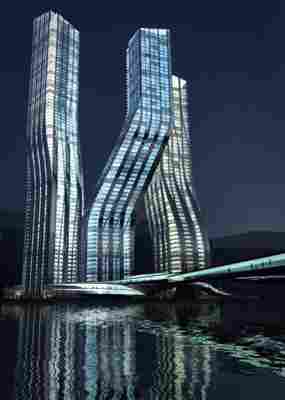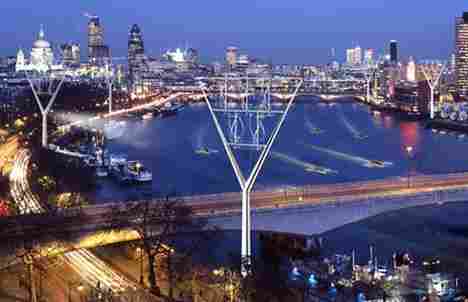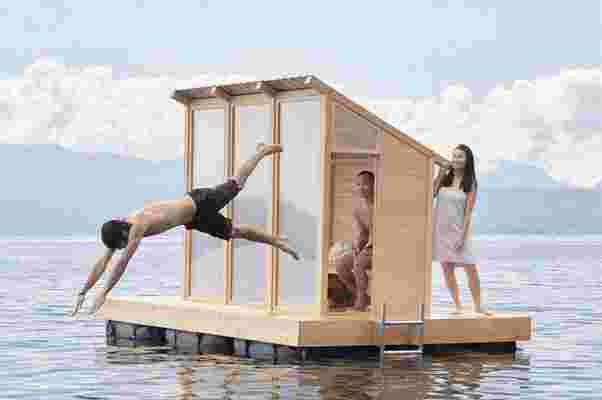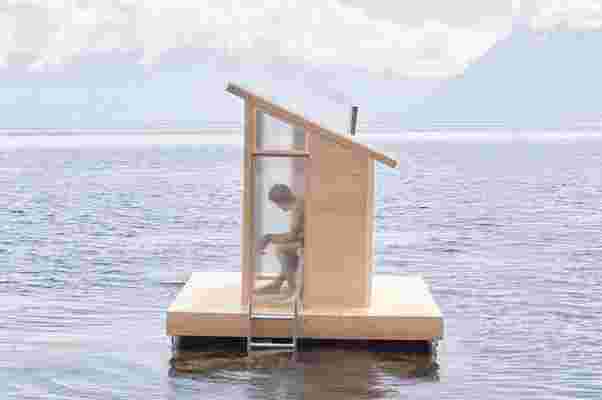Zaha Hadid’s design for the Dancing Towers confirms the role of Business Bay Development at the very forefront of Dubai’s rapidly changing future. The three towers rise above the creek and project themselves as an icon for the surrounding developments and for the gulf region.
The tower’s striking design creates a new presence that punctures the skyline with a powerful recognizable silhouette. The fluid character of the towers is generated through an intrinsically dynamic composition of volumes.
The towers are inter-twinned to share programmatic elements and rotate to maximize the views from the site towards the creek and neighbouring developments.
The design quality of the towers to act as a symbol and icon extends beyond their scale and location. These qualities are derived from the boldness of the architectural concept, from the choreographed’ movement that combines the three towers in one overall gesture and weaves’ with a series of public spaces through the podium, the bridges and the landscape beyond.
Designer: Zaha Hadid [ Via: International Design Forum ]

Wind-powered London by Marks Barfield
Architect says London could meet half of energy needs by installing thousands of wind turbines alongside rivers and roads.
London Eye architect Marks Barfield has called on London mayor Ken Livingstone to install thousands of wind turbines across the capital to meet his renewable energy targets.
A team including MBA, environmental consultant XCO2 and engineer Price & Myers claims that half of the mayor’s aim to generate 665 GWh per annum from renewable sources could be met by placing one specially-designed wind turbine every 24 hectares.
The team has calculated that 600 structures could be placed along the length of the Thames, 1800 around the M25 and 4170 along 580km of roads in the capital.
The turbines the team is proposing are 40m high, Y-shaped structures that should rise above the city’s rooftops. Each one would generate over 50,000kWh per annum and would be directly connected into local grids.
Designer: Marks Barfield

This tiny floating sauna is the perfect way to end a day spent swimming outdoor in the chilly lakes!

Löyly is a prefabricated floating sauna that can accommodate up to three people and comes with a built-in wood stove for summer afternoons spent seaside and basking in the heat.
In recent years, our fascination for microarchitecture has soared. Our own backyards are now home to tiny offices and prefabricated leisure cabins . Across the world, public parks and urban spaces are seeing more and more miniature communal structures crop up that are designed to be WiFi hotspots and charging hubs. Bringing microarchitecture to the seaside, product and spatial designer Trolle Rudebeck Haar designed Löyly, a prefabricated floating sauna.

Built from Swiss wood, Löyly keeps an organic, unstained look and an overall clean and angled shape. The floating sauna features a shed roof that slopes up in one direction to create some headroom when standing. The roof seems to be formed from corrugated polycarbonate and the side paneling comes from a material similar to reeded glass film for a translucent look that also provides some privacy from the outside. Inside Löyly, a small bench allows seating for up to two to three people and the translucent window panes offer up-close views of the surrounding water and Swiss Alps in the distance. Besides the small bench, Trolle Rudebeck Haar incorporated a wood stove by MORZH, a wooden stove and sauna designer.
Microarchitecture hosts an array of practical purposes that encourage tiny, sustainable living and consolidate home comforts to span a smaller carbon footprint. Then, some microarchitecture designs remind us what fun tiny clubhouses can be. Löyly, the floating sauna in Copenhagen, is always accessible by swimming up to its sliding doors and using the pull-down steel ladder for entry aboard the pontoon to give you a fun afternoon spent seaside and basking in the heat.
Designer: Trolle Rudebeck Haar








